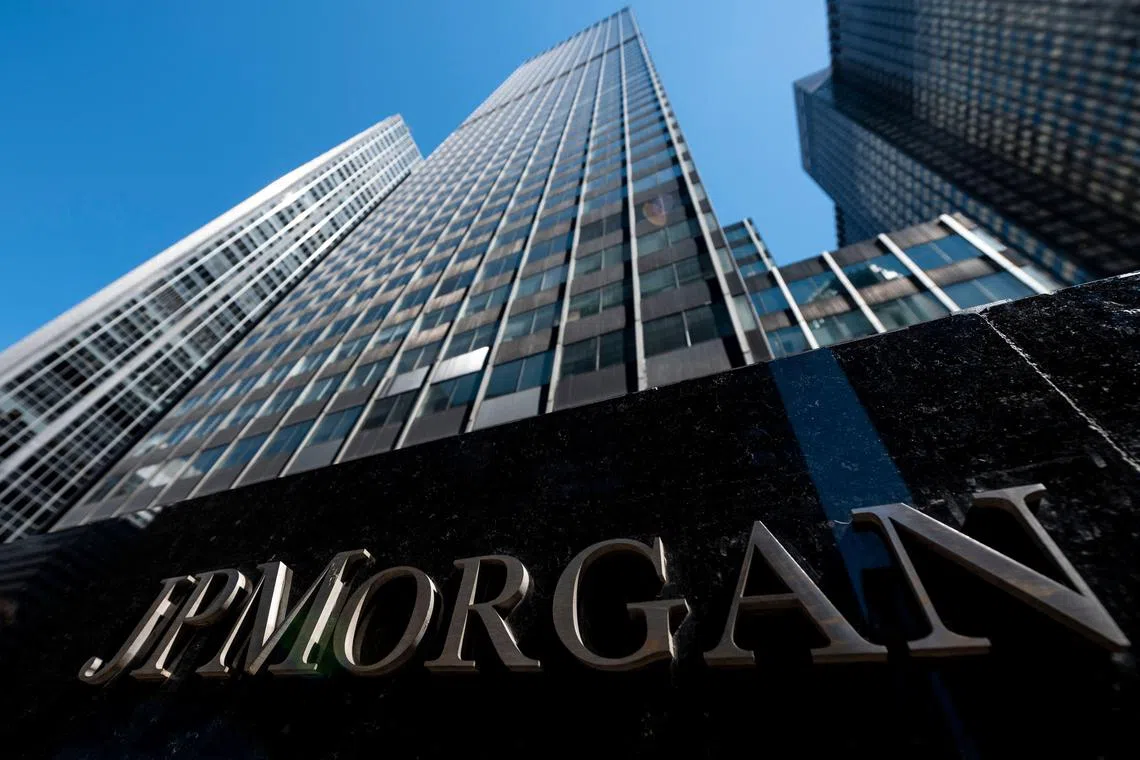Biggest US banks report bumper profits amid industry turmoil
Sign up now: Get ST's newsletters delivered to your inbox

JPMorgan Chase, the largest US bank, reported revenue that rose virtually across the board.
PHOTO: AFP
Follow topic:
NEW YORK – Despite tenuous times for the banking industry, some of the largest US lenders reported banner first-quarter earnings on Friday that easily exceeded investor expectations. And even as they warned that credit could become more scarce and expensive, they said the US economy was proving resilient so far.
The banks’ earnings were bolstered by higher interest rates, which allowed them to charge more for loans above what they pay out on deposits.
The robust reports were also a reflection that the collapse of Silicon Valley Bank and Signature Bank in March appears to have strengthened the biggest banks by driving customers toward larger institutions perceived to be more stable.
JPMorgan Chase, the largest US bank, reported revenue that rose virtually across the board, helping it pull in US$12.6 billion (S$16.8 billion) in profit, a 52 per cent jump from the same quarter a year earlier. Its customer deposits rose slightly in the first quarter from the previous quarter, with inflows picking up in particular after smaller competitors saw depositors pull cash en masse, the bank said.
“We had a rough spell in March, but things are looking better now,” said JPMorgan’s chief financial officer Jeremy Barnum.
His boss, CEO Jamie Dimon, who has taken a leading role in bailing out smaller lenders, said the banking crisis was distinct, but that financial conditions were likely to tighten as lenders, including JPMorgan, become more conservative.
“We are going to eventually have a recession, but that may be pushed off a bit,” he said.
Citigroup, the US’ third-largest lender, reported a profit of US$4.6 billion in the first quarter, up 7 per cent from the same period in 2022 and well above forecasts. Revenue jumped 12 per cent from the previous year, which came “despite the tumultuous environment for banks”, Ms Jane Fraser, the bank’s chief executive, said in a statement.
The bank’s loan book was roughly unchanged, and deposits fell 3 per cent from the previous quarter.
Wells Fargo also surpassed analysts’ expectations, reporting a profit of nearly US$5 billion in the first quarter, a 32 per cent increase from a year ago. Rising interest rates lifted the bank’s earnings as its loan portfolio grew, led by gains in personal lending and higher credit-card balances.
There was little sign of nervous depositors fleeing to the safety of the lender, the fourth-largest US bank. The average deposits at Wells Fargo dropped US$24 billion, or 2 per cent, from the previous quarter.
Mr Charlie Scharf, the bank’s CEO, said Wells Fargo was “glad to have been in a strong position to help support the US financial system” during the industry’s recent turmoil.
The bank’s top priority, he said, remains improving its internal controls; the bank has for years been battered by regulators and has paid billions in fines for a wide variety of misdeeds.
Analysts are closely watching banks for signs of tightening lending that could lead to a credit crunch, but Wells Fargo “hasn’t substantially changed our credit risk appetite” over the last quarter, according to Mr Michael P. Santomassimo, the bank’s chief financial officer.
“Consumers and many of the businesses that are our clients came into this environment in a very strong position,” he said. “Consumers continue to spend.”
Investors welcomed the batch of bank reports, their first look inside the books of the industry bellwethers since the failure of Silicon Valley and Signature Bank, sending share prices higher. JPMorgan’s stock jumped 6 per cent in premarket trading, leading the gains among banks.
“The banking system is very sound – it’s stable,” Ms Lael Brainard, director of President Biden’s National Economic Council, said this week at an event in Washington. “The core of the banking system has a great deal of capital.” NYTIMES

